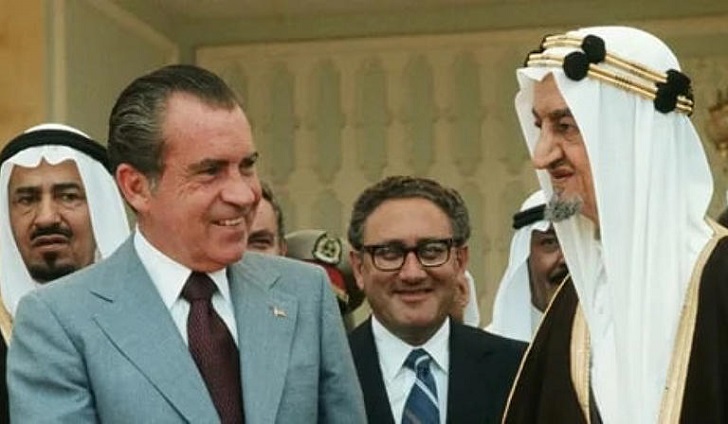
Is the Petrodollar Dead?

The dominance of the U.S. dollar in global trade, particularly in the oil market, has been a cornerstone of international economics for decades. Since the establishment of the petrodollar in the early 1970s, it has bolstered the U.S. economy, supporting its currency as the world’s primary reserve. However, recent geopolitical shifts and economic strategies from major global players like China and Russia threaten its continued dominance. Is the petrodollar dead? This comprehensive will provide what you need to know about the current situation of the petrodollar.
Historical Context and the Rise of the Petrodollar

The New Indian Express | MSN | U.S. ingeniously created the petrodollar system through an agreement with Saudi Arabia.
Following World War II, the United States emerged with the largest gold reserves, allowing it to anchor the global monetary system around the dollar, a system established at the 1944 Bretton Woods Conference. Initially, global currencies were pegged to the dollar, which itself was convertible to gold at a fixed rate.
This arrangement proclaimed the dollar as “as good as gold.” However, the pressures of increased government spending and the fixed gold rate led to a drain on U.S. gold reserves, prompting President Nixon to sever the dollar’s tie to gold in 1971. This move could have destabilized the dollar’s value in international trade.
To preserve the dollar’s supremacy, the U.S. ingeniously created the petrodollar system through an agreement with Saudi Arabia. Under this system, oil transactions globally were conducted in U.S. dollars. In return, the U.S. provided military and political support to Saudi Arabia. This not only maintained the demand for U.S. dollars but also integrated the dollar deeply into the global economy, as countries needed to hold vast reserves of the currency to engage in oil transactions.
The Petrodollar’s Impact on Global Economics
The petrodollar system significantly influences global economic strategies. By necessitating the holding of U.S. dollars for oil transactions, it creates a substantial artificial demand for the dollar, differentiating it from local currencies like the Mexican peso. This system ensures that the dollar remains a preferred medium for oil transactions and other international trade dealings, underpinning its role as the world’s leading reserve currency.
Moreover, recycling petrodollars into U.S. Treasuries has allowed the United States to sustain large budget deficits by issuing more government debt without facing the dire consequences typically associated with such financial practices. The petrodollar system has made the financial environment possible, where multi-trillion dollar deficits have become a norm rather than an economic calamity.
Is the Petrodollar Dead? The Current Challenges
Despite its past success, the petrodollar system is under unprecedented strain. Key global players, particularly China and Russia, pose serious challenges.
Russia’s significant energy production capability and China’s massive energy consumption needs have driven these nations to establish alternative trading systems, such as the Shanghai International Energy Exchange, which allows oil trades in yuan instead of dollars. This move towards what might be termed a “petroyuan” system reduces global reliance on the dollar, undermining its unique position.
Moreover, U.S. sanctions, such as those imposed on Russia following its invasion of Ukraine, have highlighted the vulnerabilities associated with holding dollar reserves, which can be frozen or seized by the U.S. government. Such actions reinforce the perception of the dollar as a risky asset, prompting nations to seek alternatives.
More in Business & Investments
-
`
Exploring Jeff Bezos’ IQ: Strategies for Success and an Intellect That Sets Him Apart
Jeff Bezos, the iconic American entrepreneur, investor, and founder of Amazon, is renowned not only for his business acumen but also...
April 14, 2024 -
`
How Safe is New York to Travel Now? Some Tips For Safety in NYC
Is it safe to travel to New York right now? This question seems to be on everyone’s lips these days. With...
April 12, 2024 -
`
Top 5 QuickBooks Alternatives to Try in 2024
More than ever before, finding the right tool that fits perfectly with your business needs can be a challenge today. Although...
April 5, 2024 -
`
How Long Are Passports Good for? A Detailed Guide
Ever found yourself rummaging through drawers, trying to locate your passport the night before an international flight? In that moment of...
March 28, 2024 -
`
Annette O’Toole and Michael McKean’s Timeless Hollywood Marriage
The love story between Annette O’Toole and Michael McKean is a beacon of enduring partnership – especially when it comes to...
March 23, 2024 -
`
Shifting Gears: Successfully Transitioning Your Client Base Across Industries
Ever feel that entrepreneurial itch to push your boundaries and explore new horizons? Perhaps you started with a laser focus on...
March 16, 2024 -
`
Music Icon Dolly Parton Reveals Secrets to Her $440 Million Fortune
Beloved country music legend Dolly Parton has long been an enigma wrapped in a rhinestone-studded enigma. At almost 80 years of age,...
March 9, 2024 -
`
Scaling Up Your Small Business: A Tightrope Walk With a Winning Plan
Building a thriving small business is like nurturing a seedling. You pour your heart and soul into its growth, watching it...
February 27, 2024 -
`
Is SZA All Set to Launch the Next Big Celebrity Makeup Line?
Today, celebrities launching their makeup lines have become as much of a trend as their next hit single. Among the glittering...
February 19, 2024

















You must be logged in to post a comment Login